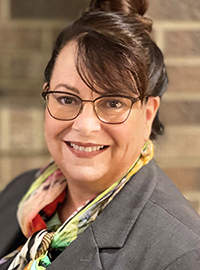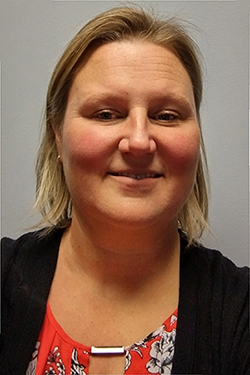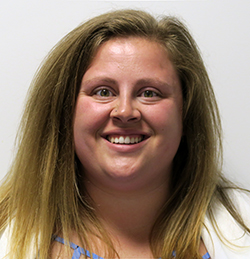 |
|

|
 |
TABLE of CONTENTS
 |
Newly named snowplows get ready for action |

The second highest vote getter in MnDOT’s 2021-22 Name a Snowplow contest—Ctrl Salt Delete—takes time for a photo op at the Windom Truck Station in District 7. Ctrl Salt Delete received more than 21,000 votes to earn that honor. Who’s your local mascot? Check out MnDOT’s website. Photo courtesy of the Windom Truck Station |
| |
|

|
 |
TABLE of CONTENTS
 |
MnDOT exceeds 2021 On-the-Job Training program goal |
By Joseph Palmersheim

One of the alums of MnDOT’s On-the-Job Training program is Akeethia Brown, equipment operator, who graduated to journey level in 2020. She has worked nearly 4,900 hours on MnDOT highway heavy construction projects. She is pictured at the I-35W@94 Downtown Crosstown Project. Photo by Lee Zutz |
MnDOT’s On-the-Job Training program placed 211 trainees in jobs in highway construction careers last year.
That number exceeds the program's original goal of 130 trainees, marking the fourth year in a row that the program exceeded its trainee goal number.
“The On-the-Job Training program’s goal is to create a more diverse workforce by providing training in highway construction to people of color, women and disadvantaged populations,” said Commissioner Margaret Anderson Kelliher. “MnDOT is committed to improving access to positions and enhancing career opportunities for historically underserved individuals.”
Trainees identified as:
- Hispanic or Latino, 31 percent
- Caucasian, 23 percent
- African American, 19 percent
- American Indian or Alaska Native, 15 percent
- Asian or Pacific Islander, 8 percent
- Two or more ethnicities, 4 percent
Nearly 39 percent of the 2021 trainees were women.
Program participants pursued trade training in the following fields:
- Truck driver (14)
- Pile Driver (13)
- Equipment operator (51)
- Laborer (105)
- Iron Worker (1)
- Electrician (4)
- Cement Mason (8)
- Carpenter (15)
OJT participants start as trainees in whatever trade they have chosen or get assigned to. The amount of time an OJT is a trainee is based on the hours established by the Minnesota Department of Labor and Industry. This varies by trade, between 2,000 hours and 7,000 hours. After completing the training requirement, the employee advances to the “journey level.” Journey-level employees do not need to work under the supervision of other journey-level workers, and earn more money than apprentices or unskilled workers.
Nineteen trainees reached journey-level status with the program this year. Seventy-four employees have reached this status since 2018.
“Even with COVID, and these pandemic years, the number of OJT participants has increased,” said Chris Clarke, OJT program coordinator, Office of Civil Rights. “One thing the industry talks about is the challenge of finding workers to work in highway heavy industry jobs. They’re encountering shortages, so providing on-the-job training may be one avenue they haven’t explored before.”
MnDOT’s OJT program is administered by the Office of Civil Rights. The program is a collaboration with MnDOT, the Federal Highway Administration, Tribal Governments, training providers, community-based organizations and construction contractors.
“It’s important to have these roles represent the populations of Minnesota as a whole,” Clarke said. “People need to see that there are people like them who are working on these projects.”
More information is available at mndot.gov/civilrights/ojt-program.html. |
| |
|

|
 |
TABLE of CONTENTS
 |
Application process to select new transportation commissioner is open through Feb. 24 |
Gov. Tim Walz is accepting applications through Feb. 24 from candidates who wish to be the state’s next transportation commissioner.
Commissioner Margaret Anderson Kelliher, who has served as the agency’s head since January 2019, announced last month that she had accepted an offer to become the Director of Public Works for the city of Minneapolis. Her last day as MnDOT commissioner is March 1. Deputy Commissioner and Chief Engineer Nancy Daubenberger will serve as temporary commissioner until the governor appoints a new commissioner.
“Commissioner Margaret Anderson Kelliher’s efforts to improve and expand our state’s extensive transportation system put the Minnesota Department of Transportation in a strong position for the future,” said Gov. Tim Walz. “I am thankful for the dedicated public servants who will step forward and apply to lead this important agency.”
Applicants should submit a cover letter and resume to gov.appointments@state.mn.us. Application materials are due by Feb. 24, and should be addressed to the governor. Applicants can contact gov.appointments@state.mn.us or 651-201-3400 with questions about the application process or to request reasonable accommodations. |
| |
|

|
 |
TABLE of CONTENTS
 |
Staffing updates |

Liz Benjamin is Metro District’s manager for the Construction, Materials and Surveys office. Submitted photo |
MnDOT has appointed several employees to leaderstip positions around the agency.
Liz Benjamin will oversee Metro District’s Construction, Materials and Surveys
Liz Benjamin is Metro District’s new manager for the Construction, Materials and Surveys office, effective Feb. 2. She replaces Michael Beer, who recently was appointed assistant director for the Engineering Services Division.
Benjamin has worked for MnDOT for over 30 years and brings considerable experience in construction administration to her new role. She has a Bachelor of Science in Construction Engineering from Iowa State University, with additional course work in Civil Engineering from the University of Minnesota.
Benjamin has over 20 years’ experience as a Metro District Resident Engineer and with both design-bid-build and design-build contract administration.
Josh Knatterud-Hubinger appointed MnDOT’s interim chief financial officer

Josh Knatterud-Hubinger will serve as MnDOT’s interim chief financial officer. Submitted photo |
Deputy Commissioner and Chief Operating Officer Kim Collins announced that Josh Knatterud-Hubinger will serve as MnDOT’s interim chief financial officer, temporarily filling the vacancy left with the departure Feb. 15 of Kristi Schroedl, who is joining the Minnesota Legislative Budget Office as its deputy director.
Knatterud-Hubinger has been the agency budget director for the past four years and has held various positions within the Office of Financial Management during his almost 15 years with MnDOT.
Mark Nelson to lead Office of Transit and Active Transportation
Mark Nelson will serve as the director for the Office of Transit and Active Transportation, effective Monday, Feb. 14, through December 2022. Nelson is filling in behind Tori Nill, who has taken a mobility assignment as District 7’s assistant district engineer for construction.

Mark Nelson is the director for the Office of Transit and Active Transportation. Submitted photo |
Nelson has over 18 years of experience with MnDOT, most recently, as the assistant office director for Program, Implementation and Transportation Access in OTAT.
He also has worked as a planning director and project manager in various offices, including Traffic Safety and Operations, Office of Investment
Management and Office of Transportation System Management. He also has been the Office of Statewide Multimodal Planning director, and served as the Metro District North Area Manager.
Prior to MnDOT, Nelson worked as a consultant for URS Corporation, a research associate for the Center for Transportation Research and Education at Iowa State University, and a research coordinator at the University of Washington in Seattle.

Nicki Bartelt is the acting director of the Bridge Office Submitted photo |
Nicki Bartelt to serve as acting director of Bridge Office
Nicki Bartelt will serve as acting director of the Bridge Office with the departure of Kevin Western, who retired Feb. 15.
Bartelt currently is the Bridge Planning and Hydraulics engineer. Her experience at MnDOT includes working in Bridge Hydraulics, Project Management, and Environmental Stewardship. She worked for the Michigan Department of Transportation before coming to MnDOT in 2006 as a rotating Grad Engineer.
Bartelt graduated from Michigan State University and has a Master of Science in Environmental Engineering with an emphasis in water resources and a Bachelor of Science in Civil Engineering. |
| |
|

|
 |
TABLE of CONTENTS
 |
State research program funds projects to address transportation challenges |
|
By Micaela Resh, Office of Research & Innovation
From a competitive pool of more than 75 proposals, MnDOT and the Minnesota Local Road Research Board have selected 25 new projects to receive research funding and are seeking volunteers to serve as Technical Advisory Panel members and help guide the research. Most projects are anticipated to begin July 2022 or sooner.
Researchers will address transportation challenges, such as:
“This is a truly impressive group of new research projects that will address a diverse set of research needs,” said Marcus Bekele, program coordinator in the Office of Research & Innovation. “We appreciate all of the project champions and subject matter experts who have supported the process from idea to project selection.”
Each spring, the MnDOT Research Steering Committee and the Minnesota Local Road Research Board solicit research ideas from transportation practitioners and later request proposals from universities. In December, the research governing boards meet to hear these proposals and select projects for funding. To receive updates on any of the funded projects, select “subscribe” on the project webpage. To volunteer for a project advisory team, contact Dave Glyer.
Have an idea for MnDOT's next funding cycle? Ideas are due March 15 for 2022 projects. Visit IdeaScale to submit your idea.
|
| |
|

|
 |
TABLE of CONTENTS
 |
Data stewards outline best practices for file-naming |
|
By Megan Bauer, Office of Chief Counsel

Adrienne Hedlund is part of a team that developed the best practices for file-naming conventions. Submitted photo |
Successful file management begins with effective file-naming. Naming files in a way that describes what they contain helps employees stay organized, identify files easily, and find what they need quickly.
The Data Domain Stewards or DDS Governance Group recently approved Best Practices for File-Naming for the major MnDOT file storage systems. DDS recommends the use of these file-naming conventions for personal drives, shared drives, ProjectWise, SharePoint, Microsoft Teams, and eDOCS.
DDS indicates that file-naming best practices prevent errors and help employees easily identify documents. Specific DDS file-naming recommendations include:
- Capitalize the first letter of every word.
- Avoid special characters like \/ : * ? ” < >|[ ] & $ , .
- Use dashes between words instead of periods, spaces or underscores.
- Identify the file category or describe its purpose in a few words.
- Provide additional information like dates, versions, and names as needed.
Examples of file names following these recommendations include:
- Content-Management-Integration-RFP.docx
- Guidelines-For-IT-Use-At-MnDOT.pdf
- 20210710-Agenda-Governance-Committee.docx
- 2d110615-Basemap-v02.dgn
- 6283-170-Agreement-87054-Qwest-Corp.pdf
- Doe-Jane-IDP-2021.xlsx
Adrienne Hedlund, Business Integration Support, along with district training staff, began developing the file-naming conventions at the request of MnDOT district employees.
“We realized our document naming was not very consistent and employees had trouble finding our documents,” said Hedlund. “I reached out to the Chief Counsel’s office to let them know our goal and they supported us in creating file-naming conventions.”
When Hedlund asked the Office of Chief Counsel for input this summer, OCC shared the group’s initial recommendations with file storage system experts from across the agency. Greg Hruby, resident ProjectWise expert, described the process as “a methodical review that took in a wide perspective.”
“The process had its moments of waiting and doubt,” said Hruby, “which indicates real true consideration by participants. As a result, the document will have usefulness across the agency. It aligns with CADD file naming conventions that have existed since 2004.”
DDS recommends following these file-naming best practices for new and frequently used files unless they contradict current guidance for your business area. If you believe that the recommended file-naming best practices may improve file management in your business area, work with your manager or supervisor to identify which practices best meet your business needs.
Refer to frequently asked questions about file-naming best practices or contact Information Governance Program Supervisor Jennifer W. Witt for more information. Visit the Information Governance Program SharePoint page for additional file storage guidance. |
| |
|

|
 |
TABLE of CONTENTS
 |
New library materials available |
The latest issue of New Library Materials is available. This issue features “Black Feminist Politics from Kennedy to Trump,” by Duchess Harris.
New Library Materials is a compilation of resources added to the library collection during the previous month. Visit mndot.gov/library/stay-current.html and click New Library Materials to sign up. Questions and feedback are welcome at Ask a Librarian.
|
| |
|

|
 |
TABLE of CONTENTS
 |
On the job: Abby Hinrichs develops scope, cost estimates for District 2 projects |
By Rich Kemp

Abby Hinrichs is a predesign engineer in District 2. Submitted photo |
Abby Hinrichs is a predesign engineer in District 2. She has been with MnDOT for four years since earning her bachelor’s degree from North Dakota State University in civil engineering. She joined MnDOT as part of the Graduate Engineer Program in District 2 and has done rotations in planning, design, traffic, construction and in the Office of Environmental Stewardship in St. Paul.
What do you do in your job?
My job consists of developing the scope and cost estimate of most of the projects within District 2. I also supervise two other staff members, one of whom develops geometric layouts for the district and the other is our district ADA expert.
What is a typical day like?
My typical day varies quite a bit. Usually over a week I will have a few meetings, whether they’re with a specific functional group or with a much larger group from across the district, to work on defining specific parts of different projects. The rest of my work with scoping and estimating is fit in between meetings. I will also work with the other two predesign staff members in a planning and decision-making capacity.
What is your favorite part about your job?
I enjoy that I get to see such a variety of projects come through. My role is a little broader in that even when a project will be designed by a consultant, it typically will still go through the scoping process in-house so I get to see just about every project the district will be working on over the next few years.
What are the biggest challenges?
The biggest challenges are pulling together information from so many different departments to form a single cohesive scope. There are frequently recommendations that are at odds with each other, so working through the pros and cons to get to the best choice is a common occurrence.
What kind of changes have you seen in your job?
Lately we have been working on a more defined schedule for scoping. As of now, the scoping package in P6 (the current schedule management tool) leaves a lot to be desired so we are trying to make it more useful for the way the scoping process is completed in District 2.
How do you help with District 2’s communications and engagement efforts?
I frequently end up in public engagement videos and in-house videos that the communications group puts together.
Has your job changed a lot because of COVID-19?
It’s hard to answer how my job has changed with COVID-19 as I started this role several months into the pandemic and working from home. It has changed the scoping process somewhat with having all our meetings online, but not necessarily in a bad way, just different.
Do you or a co-worker have an interesting job to share with readers? Send us your ideas, and we’ll contact you for more information.
Recent employee profiles:
|
| |
|
| |
|



